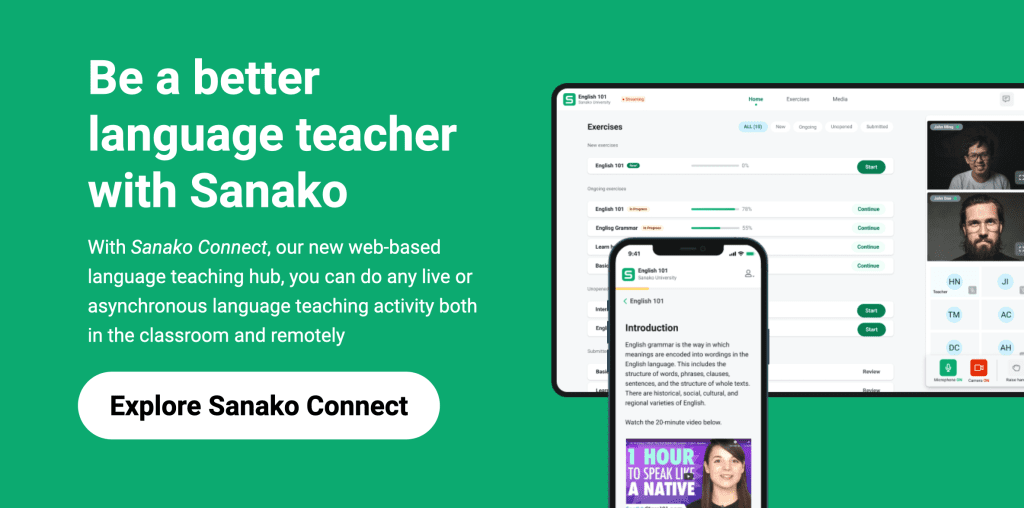Learning any new language is a challenging task. Whether that’s quickly coming up with an answer during a conversation or reading through some text to extract key information, the journey to second language fluency takes time and hard work. This is particularly true when it comes to writing lengthy pieces of text or essays – it’s a massive leap up from translating or writing short sentences.
This skill is particularly important for university students or adult language learners, who are usually trying to develop professional writing skills for international business roles or academic studies. Yet the ability to construct compelling written text is a key, albeit difficult, skill to acquire. This blog post outlines six tips for language teachers to use to help and support their students to write clearer and better structured essays.
6 tips to build your students’ essay writing skills
1. Get the basics right
It is clearly unrealistic to expect students to suddenly be able to write an essay in the target language without support. Build up their confidence over time so that they become familiar with writing increasingly long pieces of text. A key part of this will be to ensure that they understand sentence connectors and know how to write simple, compound and complex sentences – these are the foundations on which more advanced skills can then be developed.
2. Don’t jump straight in
Even in a timed exam situation, it is vital that students take the time to plan their writing and to work out the key points that they wish to communicate. This is also an opportunity for them to identify specific vocabulary or phrases that they might want to include.
Depending on their ability, some of this work can be scaffolded by the teacher to support and encourage progress. Perhaps your students could begin by following an essay structure / word bank you’ve provided or working through a set of questions you’ve prepared? They could then progress to working collaboratively in pairs or groups before tackling a long writing task on their own.
Mind mapping can also be a useful tool to help students organise their ideas and articulate their thoughts before putting pen to paper. It also helps provide a clear reference point for students to revisit whilst writing to ensure that they are still answering the question set!
3. Follow a structure
For most students being asked to write a 1,000 word essay will, at first, feel like a huge ask. So help them to make it feel less of a challenge by breaking it down into manageable chunks. The 5-paragraph essay structure is widely used for second language writers and provides a clear road-map for students to follow.
- Paragraph 1: This is meant to grab the reader’s attention, give them a clear idea of what’s to come and generally sets the tone for the rest of the piece.
- Paragraphs 2 to 4 form the core of the essay’s content. These make specific points that are then backed up by a variety of evidence.
- Paragraph 5 delivers the conclusion, pulling together all of the arguments along with a summary of the key points.
Students may also find the acronym P.E.E useful when writing paragraphs 2 to 4. This stands for Point, Explanation and Evidence. Paragraphs should contain clear points or arguments that support (or reject) the overall theme. This is then followed by a brief explanation and relevant evidence to reinforce the point.
Focusing on these structures can be a big help in building students’ confidence. Their attention can be focused on getting the content and language correct rather than worrying about the essay structure.
4. Share examples of great writing
When writing in their target language it can be very difficult for students to imagine or know what good writing actually looks and sounds like. So share examples with them – from books, the internet or magazines on topics that will engage and interest them.
Whilst it’s important to read them and pick up new words / phrases to include, your students may also find it useful to carefully dissect the examples in detail. Help them to identify what makes a piece of writing entertaining or persuasive and help them build the skills to try it themselves (either individually or as a group)
5. Practice, Practice, Practice
Of course, the very best way to do this is to practice. Writing more often remains the most effective way for students to improve their writing skills. Of course, some of these tasks should be done as homework, but setting small writing tasks in class reduces grade pressure and ensures that educators are on hand to answer any questions and provide constructive feedback.
Pairing students to write practice essays can also be highly effective, particularly when students of mixed ability come together. The weaker student learns from their peers and the stronger student reinforces their understanding by explaining it to their classmate.
It’s also important that educators make the time to review the outputs from writing tasks with students. Highlight the areas where students did well, show them where improvement can be made and get them to look again at grammar / words that they frequently get wrong. This process is vital – it inspires their confidence and encourages students to keep writing and to keep trying to get better.
6. More than words
Every educator will have their own view on the accuracy vs. fluency debate and how they judge the quality of written work students produce will be based on that. Of course, it’s important that students pay attention to using correct grammar, spelling etc, but it’s also vital that the aim of the piece of writing is achieved. More specifically, does it convince? Does it persuade? Does it encourage me to change my behaviour or think again about a topic?
It’s imperative therefore for educators strive to create and deliver writing lessons that cover the core writing skills but which also encourage students to expand their creativity and critical thinking. Helping students to understand the importance of how to plan and structure an argument is also, of course, valuable beyond just language learning. Ultimately these tips aim to help you ensure that students find writing a more fulfilling experience.
How can Sanako help you to teach essay writing skills?
Tools like Sanako Connect can make a big difference in helping students practice and improve their writing skills. It has been specifically designed to help language educators to do this in asynchronous or asynchronous settings. It enables teachers to easily set students tasks that test their writing skills. Connect’s flexibility also allows teachers to upload stimulus material to which students can respond with detailed written answers of any length.
Whatever approach you use to improve your students’ writing skills, Sanako’s market-leading tools include a wealth of unique features that help language educators teach languages more efficiently and more successfully. It’s why the world’s leading educational institutions choose Sanako as their preferred supplier to support online and in-person lesson delivery.
If you are interested in learning more about how Sanako products support language teachers and students and would like to see how they could benefit your institution, book a FREE remote demo now to see them in action.

